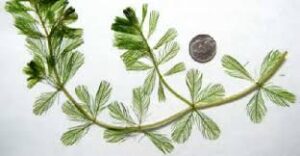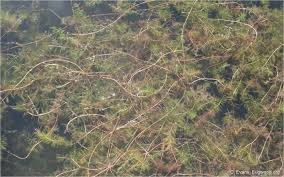One of the most concerning invasive aquatic plants is the Eurasian Water Milfoil (EWM). It is negatively affecting the health of lakes, streams and rivers throughout the US.

Eurasian Watermilfoil Facts
Deceptively delicate and fragile in appearance Eurasian Watermilfoil forms thick mats in shallow areas of a lake, quickly growing and spreading to block sunlight, killing off native aquatic plants that fish and other underwater species rely on for food and shelter. Its leaves are feather-like with 12 or more thin segments.
- Eurasian Watermilfoil is commonly found in water 3 to 10 feet deep.
- The Eurasian Water Milfoil plants are rooted at the bottom of the lake and grow rapidly creating dense beds and thick canopies.
- EWM grows both vertically and horizontally creating dense mats that affect the water flow, water absorption and quality.
- The aggressive plant can grow nearly 10 feet.
- “An EWM population could grow at a rate of an inch per day per tip. So, if you integrate all of that growth across an entire population, that is a tremendous amount of plant material assimilating each day” – Ryan Thum, University of Montana, U.S. leading expert on Milfoil
- The density of the EWM chokes out the native plants and changes the ecosystem.
- The decaying EWM plants produce phosphorus and create a muck base which in turn is the ideal environment for continued Milfoil infestation.
Eurasian Watermilfoil Growth
The predominant means of EWM spread is through fragmentation. Pieces break off from the main plant easily with minimal disturbance. These pieces are then moved to other locations by waterfowl or boats. They will then easily root and grow quickly, forming dense stands.
Despite the use of the best management practices: aquatic herbicide treatments, harvesting and manual removal strategies, invasive EWM continues to expand its coverage area of the lakes.
Rake Studies (Data from Lake County Health Department – Ecological Services)
West Loon Lake
- 2012 Survey – EWM present in 12% of surveyed sites
- 2022 Survey – EWM present in 33% of surveyed sites
East Loon Lake
- 2013 Survey – EWM present in 2% of the surveyed sites
- 2022 Survey – EWM present in 52.7% of surveyed sites
Eurasian Watermilfoil Impacts
IDNR has also raised concern about EWM’s negative impact on the lake’s ecosystem. The 2020 Threatened and Endangered IDNR report “identified aquatic plant management of the invasive plant, Eurasian Watermilfoil, as the lake management activity that is most likely to directly impact listed threatened and endangered species found in our lakes”
The increasing proliferation of EWM matting areas has also contributed to beach closings. The matting creates a ring around the lake, limiting water flow. Inside the ring waterfowl congregate and feces become trapped. Villa Rica HOA reported significant E-Coli readings at their LCHD-ES licensed beach with a huge increase in beach closings due to extremely high E-Coli readings.
Villa Rica Beach Closings due to E-Coli
2011 – 2017 beach closed an average of one day per year
2022 beach closed 37 days for just 1 year
Funding for this project was provided in part by the Lake County Stormwater Management Commission through a Watershed Management Board Grant

